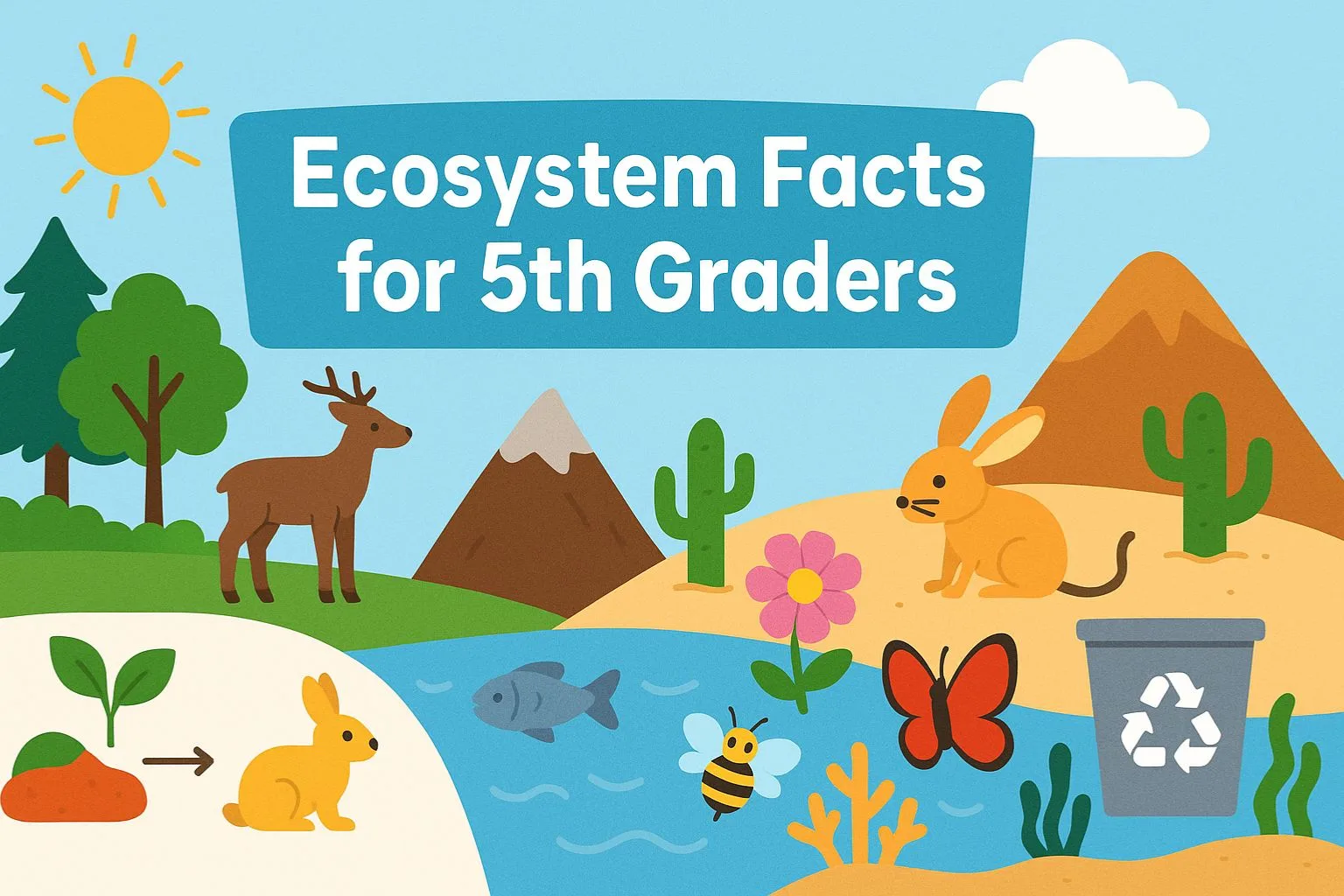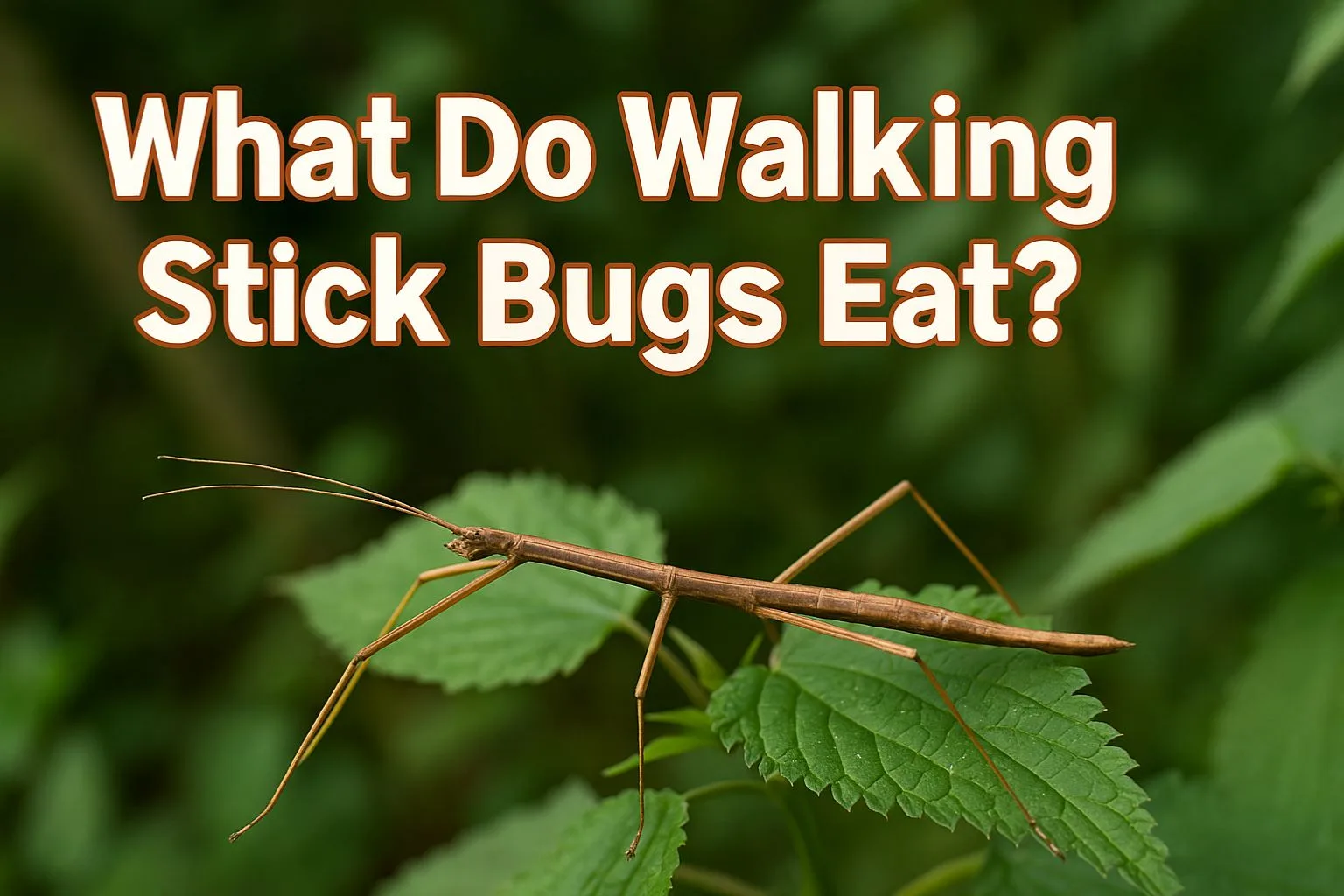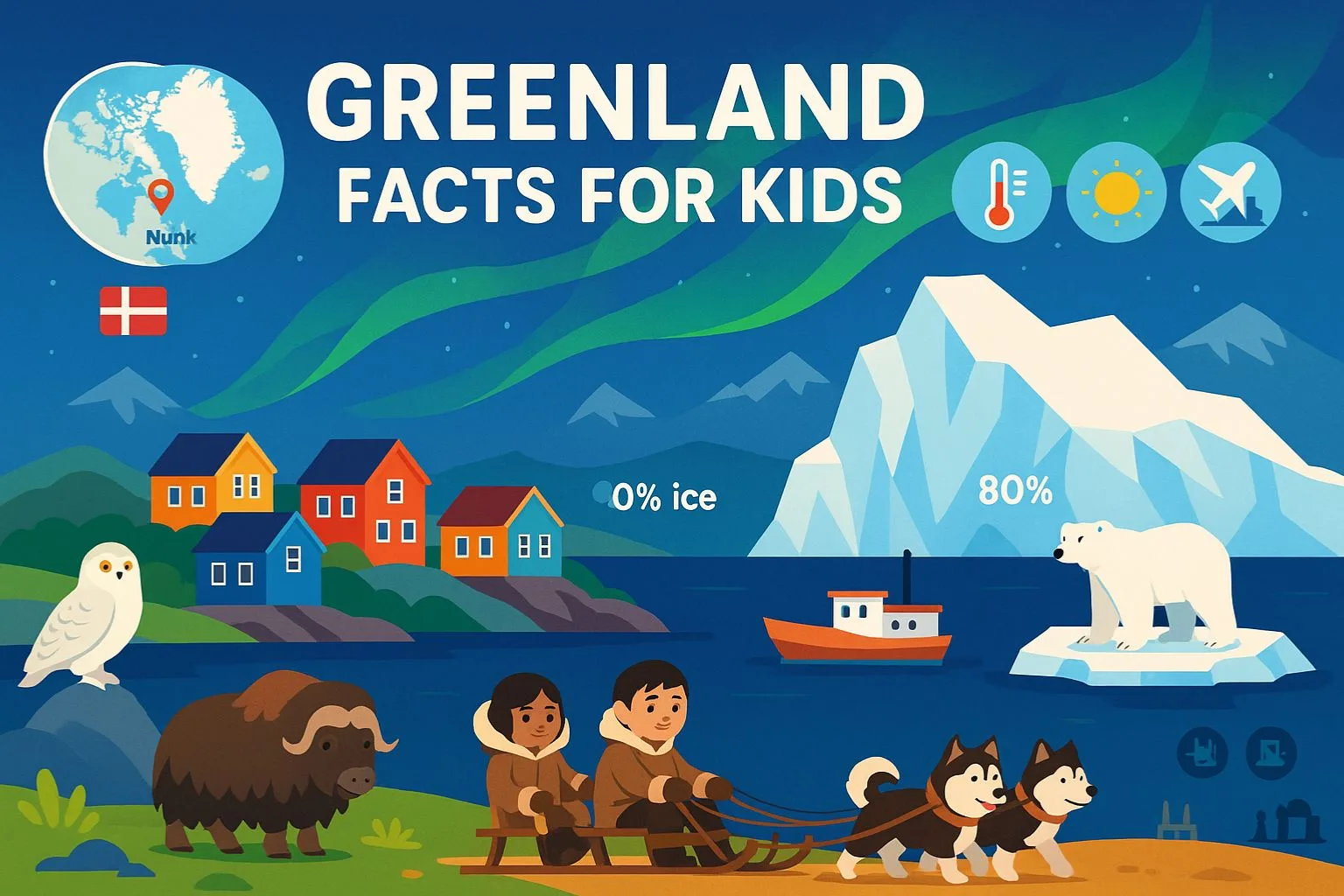Komodo Dragon is a unique lizard and is famous for being the largest lizard in the world. They are very interesting animals to study. We have gathered a complete set of Komodo Dragon Facts For Kids that will provide you with all the Komodo Dragon Information you need. You are going to learn All About Komodo Dragon i.e. its scientific name, classification, evolution, characteristics, species, appearance, size, weight, speed, sound, body parts, senses, tail, venom, habitat, lifespan, diet, hunting, food chain, eggs, reproduction, life cycle, baby, adaptations, predators, endangerment, population, and many other interesting Komodo Dragon Facts.
Komodo Dragon Facts For Kids
What Is Komodo Dragon
- A Komodo dragon is the largest and heaviest living species of lizards in the world.
- It is also known as the Komodo Monitor.
- It has a long and flathead, bowed legs, and scaly skin.
- It has a huge muscular tail, which has about the same length as the total body.
- Komodo dragons are found in the Komodo, Floris, Rinca, and Gili Motang islands of Indonesia.
- They are carnivores and eat invertebrates, birds, and mammals found in their habitat.
- It is believed that they got their huge size because no other large carnivore animals exist in their habitat to fill the niche. This biological phenomenon is known as Island Gigantism.
- Komodo dragon is listed as ‘Vulnerable’ by the IUCN Red List.
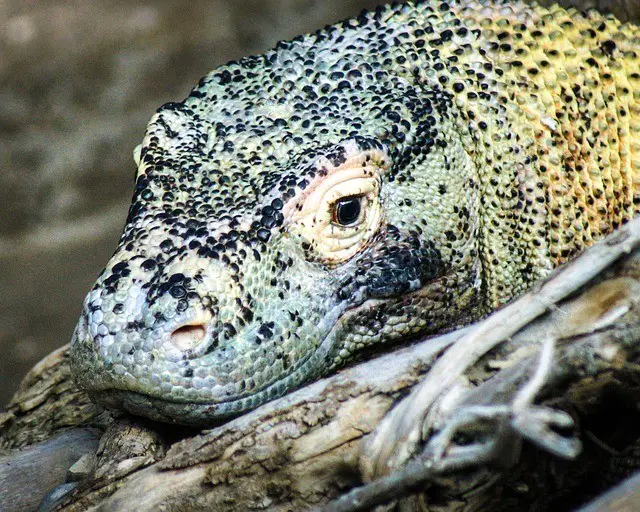
Komodo Dragon Scientific Name
- The scientific name of the komodo dragon is Varanus komodoensis.
Komodo Dragon Classification – Komodo Dragon Taxonomy
- The following is the scientific classification or taxonomy of the komodo dragon:
| Kingdom | Animalia |
| Phylum | Chordata |
| Sub-phylum | Vertebrata |
| Class | Reptilia |
| Order | Squamata |
| Family | Varanidae |
| Genus | Varanus |
| Sub-genus | Varanus |
| Species | Varanus komodoensis |
Komodo Dragon Evolution
- The origin of the komodo dragon’s genus ‘Varanus’ dates back to 40 million years ago in Asia.
- They then migrated to Australia, where the absence of competing carnivores helped their evolution into giant forms. So they became the largest of all being the recently extinct monitor lizards (Megalania).
- About 15 million years ago, a collision occurred between the continental landmasses of Southeast Asia and Australia.
- That incident allowed these varanids to return into the region that is now the Indonesian archipelago, and their range extended as far east as Timor island.
- It is believed that the differentiation of Komodo dragons and their Australian ancestors occurred around 4 million years ago.
- However, recently discovered fossil evidence in Queensland (Australia) suggests that the evolution of Komodo dragons happened in Australia before they spread to Indonesia.
- During the last glacial period (approximately 115,000 to 11,700), the level of sea dramatically lowered that exposed large stretches of the continental shelf where the komodo dragons colonized.
- Later, when the sea level rose again, it caused the isolation of those colonized komodo dragons into their present island range.
- The mitochondrial DNA analysis of the komodo dragon reveals that lace monitor (Varanus varius) is its closest relative. Their common ancestor separated from the lineage gave rise to crocodile monitors (Varanus salvadorii).
Komodo Dragon Evolution Timeline
- The following is a brief evolution timeline of the komodo dragon:
| Date | Event |
| 40 million years ago | Varanus (genus of Komodo dragon) originated |
| 15 million years ago | Collision of the Australian and Southeast Asian landmasses occurred and komodo dragons move back into the Indonesian archipelago |
| C. 115,000 to 11,700 | Large continental shelf stretches exposed due to the dramatic fall of sea level and komodo dragons colonized there |
Komodo Dragon Characteristics – Komodo Dragon Features – Komodo Dragon Special Features
- Komodo dragon is the world’s largest and heaviest living lizard found in four islands of Indonesia.
- It has an average body length of 2.6 meters (8.5 feet) and an average bodyweight of 40 to 70 kg (88 to 154 pounds).
- It has a sturdy body, a long muscular tail, and thick muscular legs.
- Its feet end on sharp claws.
- A komodo dragon has large and extremely flexible jaws.
- It has a long and deeply forked tongue.
- It has about 60 sharp, curved, and serrated teeth.
- Komodo dragons are carnivores and eat the flesh of other animals.
Komodo Dragon Species – Komodo Dragon Types
- Komodo dragon is the only species or type of its kind.
What Does A Komodo Dragon Look Like – Komodo Dragon Appearance
What Color Is A Komodo Dragon – Komodo Dragon Color
- Komodo dragons have a variety of skin colors, such as black, grey, blue, brown (like earth), and green.
- Adult individuals usually have a uniform grey, black, or earthy brown color skin.
Komodo Dragon Description – Komodo Dragon Physical Description
- Komodo dragons in the wild have an average body weight of 40 to 70 kg (88 to 154 pounds) and an average body length of 2.6 meters (8.5 feet).
- Males are usually bigger than females.
- A komodo has a long and muscular tail, which measures around equal to its body length.
- It has a large flattened head, large muscular jaws, and about 60 serrated teeth.
- It has a long, deeply forked tongue.
- The skin of Komodo dragons is strengthened with armored scales, which contain small bones known as osteoderms. Their armored skin functions like a chain-mail or chain armor.
- They have poor senses of hearing and vision and a keen sense of smell.
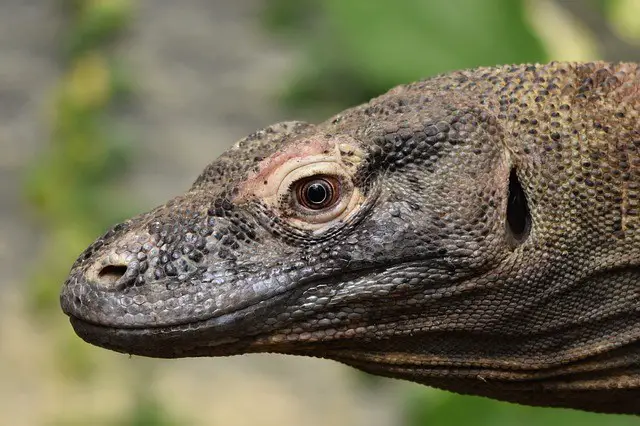
How Big Is Komodo Dragon – Komodo Dragon Size
- An adult male Komodo dragon has up to 2.6 meters (8.5 feet) body size.
- While the body size of an adult female is up to 2.3 meters (7.5 feet).
How Big Do Komodo Dragons Get – Biggest Komodo Dragon
- A komodo dragon can be as big as up to 3 meters (10 feet) in length and as heavy as 149 kg (330 pounds).
- The biggest verified specimen was 3.13 meters (10.3 feet) long with a bodyweight of 166 kg (366 pounds).
Komodo Dragon Size Comparison
- In the following table, the size of the Komodo dragon is compared with humans and some other animal species:
| S.No | Species | Average Size (meter) |
| 1 | Komodo dragon | 2.6 |
| 2 | Human | 1.7 |
| 3 | Saltwater crocodile | 5.2 |
| 4 | American alligator | 3.0 to 4.5 |
| 5 | Leatherback sea turtle | 2.2 |
Komodo Dragon Size Compared To Human
- The average size of an adult male human is 1.7 meters (5.57 feet), while the average size of an adult male Komodo dragon is 2.6 meters (8.53 feet).
Komodo Dragon Small
- Female Komodo dragons are usually small with an average body length of 2.3 meters (7.5 feet) and an average body weight of 68 to 73 kg (150 to 161 pounds).
Komodo Dragon Full Size
- A big full-size komodo dragon usually has around 10 feet (3 meters) body length.
Komodo Dragon Average Size
- The average size of an adult male Komodo dragon is 2.6 meters (8.5 feet), while that of an adult female is 2.3 meters (7.5 feet).
How Tall Is A Komodo Dragon – Komodo Dragon Height
- An adult full-grown komodo dragon usually has 3 feet in height.
How Much Does A Komodo Dragon Weigh – Komodo Dragon Weight
- An adult male Komodo dragon weighs from 79 to 91 kg (174 to 200 pounds).
- While an adult female weighs from 68 to 73 kg (150 to 161 pounds).
- The verified heaviest specimen was weighed 166 kg (366 pounds).
Can Komodo Dragons Swim – Do Komodo Dragons Swim – Komodo Dragon Swimming
- Yes, komodo dragons are excellent swimmers and swim like crocodiles.
- They can dive up to 4.5 meters (15 feet) deep.
- Through swimming, they cross the sea and move between the neighboring islands.
How Fast Can Komodo Dragon Run – Komodo Dragon Speed
- Komodo dragons can run as fast as 20 km/h (12 mph) for short bursts.
Komodo Dragon Sound
- Komodo dragons make hissing sounds.
- They typically make such noises to warn other Komodo dragons to stay away.
Komodo Dragon Body Parts
- The following are the major body parts of a komodo dragon:
- A flattened head with a big mouth, muscular jaws, serrated teeth, and deeply forked tongue
- The vomeronasal organ (Jacobson’s organ) at the nasal septum of the nasal cavity
- Two big eyes located at the lateral regions of the head
- Four legs, each leg has a five-toad foot with a sharp claw
- Long muscular tail, which is sometimes longer than its body
- Scaly skin of dark color (black, grey, or brown like sand)
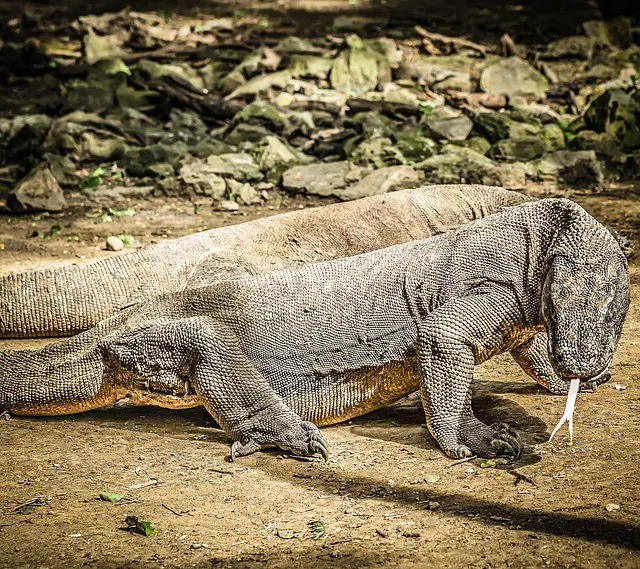
Komodo Dragon Teeth Facts
- Komodo dragons have about 60, frequently replaceable teeth arranged in two jaws.
- Their teeth are sharp and serrated like that of sharks.
- Each tooth has up to 1 inch (2.5 cm) length.
- Gingival tissue or gum completely covers their teeth.
- Their gingival tissue or gum naturally lacerates when they are feeding due to which they have blood-tinged saliva.
Komodo Dragon Tongue
- A Komodo dragon has a long and deeply forked tongue.
- It uses its tongue to smell, detect, and locate its prey.
- Its tongue can pick up small microscopic airborne test particles.
- A komodo dragon samples air with the forked tip of its tongue and then moves its tongue’s tip to the roof of its mouth to make contact with Jacobson’s organ.
- Jacobson’s organ recognizes the airborne molecules, analyzes chemicals, and so smells the prey.
- If the concentration of sample molecules is high at the right tip of the forked tongue than the left tip, the komodo dragon knows that prey is approaching from the right.
- In such a way, a komodo dragon detects and locates its prey.
- If an injured prey escapes, a komodo dragon will follow it for miles using its keen sense of smell.
Komodo Dragon Tongue Color
- The tongue of the komodo dragon has a pale yellow color.
Komodo Dragon Senses
Hearing sense
- A komodo dragon has only a single ear bone (Stepes) like other members of its family.
- They can hear sounds only in the range of 400 to 2,000 Hz.
- Formerly, komodo dragons were believed to be deaf.
- However, this belief was disputed when an employee at the London Zoological Garden trained a captive Komodo dragon to come out and eat food at the sound of her voice.
Sense of vision
- The retinas of a komodo dragon’s eyes have only cones and lack rods.
- So it is believed that they have poor night vision.
- They can see objects from a distance of 980 feet (300 meters).
Sense of smell
- Komodo dragons have a keen sense of smell.
- They use their tongue and Jacobson’s organ to smell, detect, and even locate things.
- They can smell and detect carrion from a distance of 4 to 9.5 km (2.5 to 5.9 miles).
Sense of taste
- Komodo dragons have a poor sense of taste and have only a few test buds at the back region of their throat.
Sense of touch
- The scales at the skin of Komodo dragons have sensory plaques.
- Nerve connections to these sensory plaques facilitate their sense of touch.
Komodo Dragon Tail
- Komodo dragons have long muscular tails.
- The length of their tail reaches their whole body weight.
Komodo Dragon Tail Strength
- The tail of a komodo dragon is so strong that they often use it to knock down large prey, such as deer and large pigs.
Komodo Dragon Venom
- Komodo dragons have two venom glands in the lower jaw.
- The venom glands secrete several types of toxic proteins.
- The known functions of these proteins (venom) are; lowering blood pressure, muscles paralysis, prevention of blood clotting, and induction of excessive heat loss (hypothermia).
- All these conditions lead to loss of consciousness and shock.
Where Do Komodo Dragons Live – Komodo Dragon Habitat
- Komodo dragons are found only in Indonesia, where they are confined to the islands of Komodo, Gili Motang, Rinca, and Flores.
- There, they live in a variety of habitats, such as dry tropical forest, deciduous monsoon forest, and savanna.
- Their home islands are volcanic in origin, hilly and rugged, and are covered with savanna and forests.
- They like to live in extreme heat.
- They dig burrows where they sleep at night and rest in the day to stay cool.
- Their habitat range usually has about 35 ℃ (95 ℉) temperature with about 70% humidity.
- The home range of Komodo dragons is the smallest of any other large predators.
Where Do Komodo Dragons Live In The World
- In the world, Komodo dragons live in Indonesia.
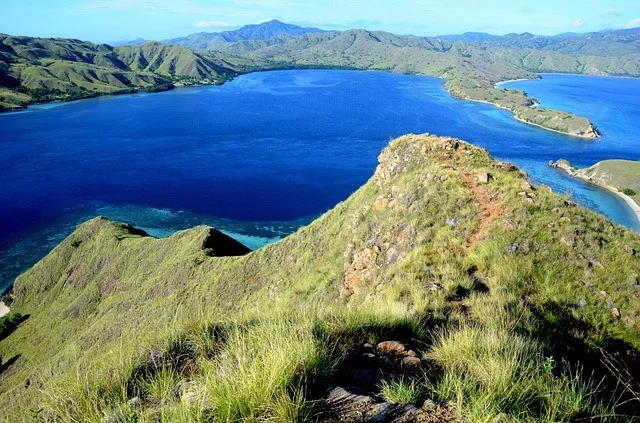
Komodo Dragon Habitat Map
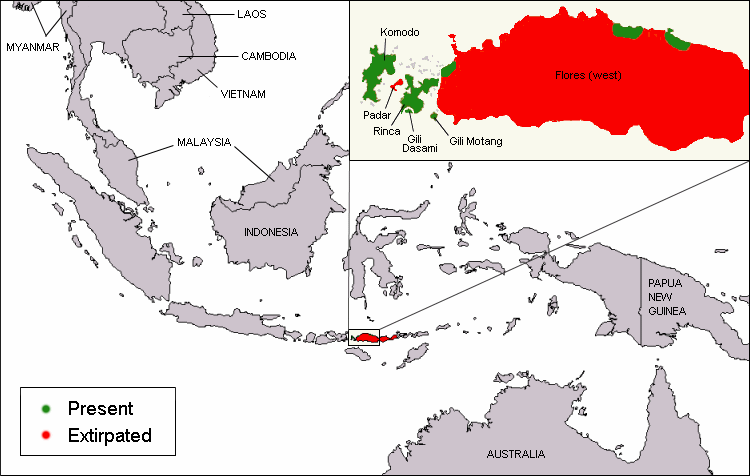
Komodo Dragon Natural Habitat
- The Lesser Sunda Islands is the natural habitat of Komodo dragons.
- They live and flourish in the harsh climate of those islands for millions of years.
- They can be found everywhere across the islands, however, they prefer the tropical forests of the islands.
- Komodo dragons like to stay close to home, and rarely move far from the region where they hatched.
Komodo Dragon In Captivity
- Komodo dragons are rarely kept in captivity.
- If captured from the wild, they are susceptible to parasitic diseases and infections.
- They also do not easily reproduce in captivity.
- London Zoo was the first that kept and exhibited komodo dragons in 1927.
- In 2009, 35 North American, 13 European, two Australian, two African, and one Singaporean institution housed captive komodo dragons.
How Long Does A Komodo Dragon Live – Komodo Dragon Lifespan – Komodo Dragon Age
- The lifespan of komodo dragons in the wild is up to 30 years.
- Unlike most other animals, komodo dragons do not do well in captivity and have short lifespans in captivity than in the wild.
What Do Komodo Dragons Eat – Komodo Dragon Diet – Komodo Dragon Food
- Komodo dragons are carnivores in nature.
- They are the dominant and top predators of their habitat and eat almost any type of animal.
- They mostly eat carrions but also frequently prey on living animals.
- Their diet is composed of a wide range of animals found in their habitat.
- They eat their food by tearing and swallowing large chunks of meat as a whole.
- They also swallow small prey (around the size of a goat) as a whole.
- In one meal, they can eat as much as up to 80% of their whole body weight.
- Komodo dragons have a slow metabolism. Adult individuals can survive on about 12 feedings per year.
- To speed up digestion, a komodo dragon drags itself to a sunny location. As the undigested food in its stomach for a long time could rot and poison the dragon.
- Komodo dragons are cannibalistic and adult individuals eat other Komodo dragons (usually juveniles) as 10% part of their diet.
Komodo Dragon Prey
- Komodo dragons hunt a wide range of animals. Their prey includes:
- Invertebrates
- Other reptiles
- Birds and their eggs
- Small mammals
- Wild boar
- Monkeys
- Horses
- Goats
- Deers
- Water buffaloes
- Pigs,
- Small Komodo dragons.
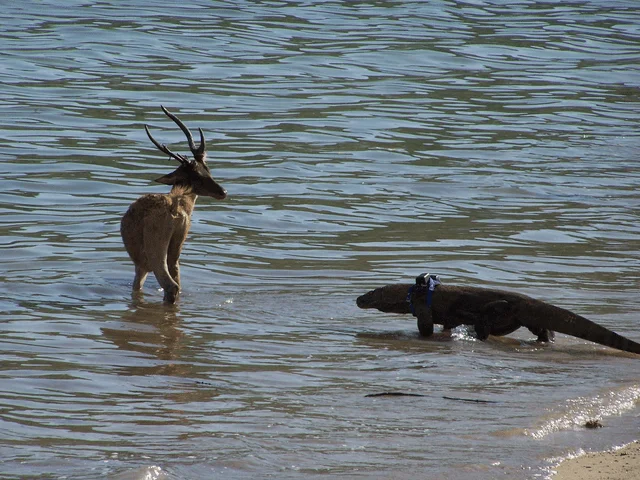
What Do Baby Komodo Dragons Eat
- Baby Komodo dragons eat insects, birds’ eggs, small mammals, and geckos.
Recommended Reading: Do Komodo dragons eat people
Komodo Dragon Hunting
- When hunting, Komodo dragons depend on camouflage and ambush prey in a stealthy approach.
- When a prey arrives close to a komodo dragon’s ambush site, it suddenly attacks the animal at a high speed and goes for the throat.
- It bites the prey with its sharp serrated teeth and uses its powerful neck muscles to pull back the prey.
- A komodo dragon does not allow its prey to escape and frequently kills it by causing fatal injuries, lacerating damage, and heavy blood loss.
- A komodo dragon also poisons its prey with venom, which causes lowering of blood pressure, massive blood loss as their venom prevents blood clotting and induces the prey to shock.
- Komodo dragons are observed and recorded for killing wild pigs within seconds.
- They are also observed for using their strong tail to knock down large prey, such as large deers and pigs.
Komodo Dragon Food Chain
- Komodo dragons are the apex predators of their habitat and exist on the top of the food chain. The following is a simple food chain of komodo dragons:
- Sun is the overall source of energy.
Producers
- Grasses and other green plants take energy from the sun and produce their food itself through photosynthesis.
Primary consumers
- Insects (such as crickets) and herbivore animals (deer, goat, buffalo, horse, etc) consume grasses and other plants.
- Savanna monitors eat insects.
- Wild pigs eat plant matter as well as savannah monitors.
Secondary consumers
- Komodo dragons and humans consume herbivore animals and wild pigs.
Decomposers
- Bacteria and fungi are the decomposers and decompose the dead matter of Komodo dragons.
Komodo Dragon Food Web
- The food web of the Komodo dragon is shown in the following image:
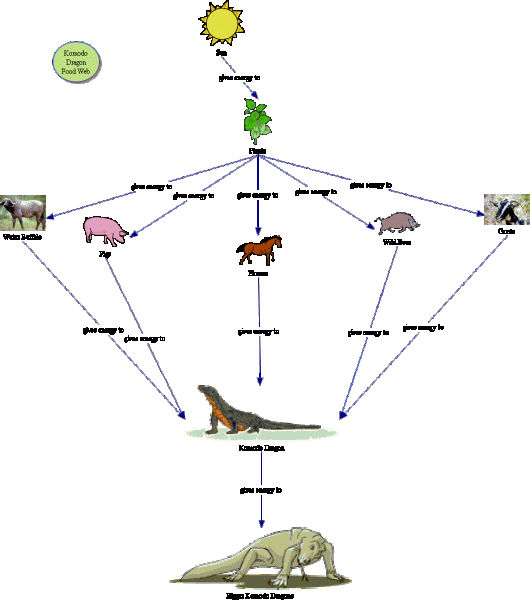
Komodo Dragon Eggs Facts
- Komodo dragons lay 15 to 30 eggs, each one has a size of a grapefruit.
- Their eggs look like fluid-filled balloons.
- All the eggs have an oval shape and have a tough texture like leather.
Do Komodo Dragons Lay Eggs
- Yes, komodo dragons lay eggs.
How Many Eggs Do Komodo Dragons Lay
- The average number of eggs a komodo dragon lays is 20.
- They lay eggs in the form of a group, known as a clutch.
- A clutch may contain from 15 to 30 eggs.
How Big Are Komodo Dragon Eggs – Komodo Dragon Egg Size
- A komodo dragon egg has a size of a grapefruit.
How Do Komodo Dragons Reproduce – Komodo Dragon Reproduction
- Komodo dragons reproduce once a year.
- When a female is ready to mate, she gives off a scent in her droppings for males to follow.
- Their mating season is between May and August.
- Females lay eggs from August to September.
- A female lays eggs in the form of a group known as a clutch.
- A clutch has an average number of 20 eggs, however, it may be as much as 30.
- Females bury their eggs in the earth until they hatch after the incubation period of 7 to 8 months.
Komodo Dragon Asexual Reproduction
- Female Komodo dragons can also reproduce asexually in a process known as parthenogenesis.
- In parthenogenesis, an embryo develops from an unfertilized egg.
- Female Komodo dragons have both types of sex chromosomes; male (Z) and female (W).
- When a female reproduces through parthenogenesis, she transfers one of her sex chromosomes into the egg, which then duplicates within the egg.
- The egg receiving the Z chromosome becomes ZZ (male) while the egg receiving the W chromosome becomes WW and fails to develop (as females have a ZW set of sex chromosomes).
- So, only male offspring are produced through parthenogenesis.
- A female reproduces in this manner if she finds no male mate.
Komodo Dragon Life Cycle
- The life cycle of a komodo dragon starts when they become sexually mature at the age of 8 to 9 years.
- Female Komodo dragons lay eggs like most other reptiles.
- The incubation time of eggs is 7 to 8 months.
- The young hatches from the eggs are quite vulnerable at birth.
- There is no evidence that parent Komodo dragons take care of their offspring.
- Komodo dragons live for around 30 years in the wild.
Komodo Dragon Baby
- Baby Komodo dragons are called hatchlings
- They hatch after 7 to 8 months of incubation.
- A baby Komodo dragon uses an egg tooth to crack the wall of eggshells from inside.
- A newly born baby has an average size of 30 cm (12 inches) and weighs up to 105 grams.
- After hatching, a baby will escape and climb up trees to avoid predators including its mother.
- The young ones spend much time of their life’s first few years in trees to avoid other komodo dragons.
- When approaching a kill or a carcass, the youngs roll around themselves in fecal matter and stay in the intestines of eviscerated animals to make themselves protected from hungry adults.
- Young Komodo dragons mature at the age of 8 to 9 years.
Komodo Dragon Baby Size
- A baby Komodo dragon has about 30 cm (12 inches) in size at the time of birth.
Komodo Dragon Adaptations
Komodo Dragon Behavioral Adaptations
- Komodo dragons are mostly active during the day, as they are Ectotherm (an organism whose bodies can not internally regulate its temperature) and relies on the environment to maintain its body temperature.
- They dig burrows, which maybe 1 to 3 meters wide, where they sleep and take shelter from the sun.
- To stay cool, a komodo dragon spends most of its daytime in its burrow.
- Their prey time is in the afternoon, however, they stay in the shade if the climate is hottest.
- They are also observed panting like dogs when they get overheated.
- A komodo dragon sticks out its tongue to smell and detect. It can detect carrion at a distance of 4 to 9.5 km.
Komodo Dragon Structural Adaptations – Komodo Dragon Physical Adaptations
- The following are some of the major structural or physical adaptations of a komodo dragon:
Dark scaly skin
- A komodo dragon has black, grey, or brown color skin armored with scales.
- Their skin provides them camouflage and also protects them from injuries when they fight with each other for food and mates.
Sharp claws
- Like other reptiles, komodo dragons also have sharp claws.
- It allows them a strong grip on their prey when they are hunting.
- They use their sharp claws to tear apart their prey and as a weapon when fighting.
- They also use their sharp claws and forelimbs to gid holes or burrows, where they sleep.
Powerful legs
- Komodo dragons have powerful legs, which allow them to run at the speed of 12 mph (20 km/h) while following the prey.
- Powerful legs also make them excellent swimmers.
Long tail
- Their long muscular tail provides them with balance when they are walking or running.
- Young individuals can also climb trees while using their tails for balance and their powerful claws for climbing.
Strong neck muscles
- Komodo dragons have extremely strong neck muscles, which they use for tearing apart their prey.
Muscular jaws and sharp teeth
- Komodo dragons have extremely muscular jaws and sharp serrated teeth like that of sharks.
- Because of muscular jaws, they can fully open their big mouth and can swallow large chunks of meat and sometimes small prey as a whole.

Komodo Dragon Physiological Adaptations
- The following are the major physiological adaptations of komodo dragons:
Vomeronasal organ (or Jacobson’s organ)
- Like most other reptiles, komodo dragons have vomeronasal or Jacobson’s organs.
- They use their tongue and Jacobson’s organs to smell, test, and detect things.
- The vomeronasal organ is a paired auxiliary olfactory or smell sense organ situated at the nasal cavity (in the soft tissue of the nasal septum) above the hard palate (or the mouth roof).
- Neurons in the Jocbson’s organ have receptors, which can detect specific liquid (non-volatile) organic compounds carried to them from the environment.
- They use their tongue to sample the air, then touch it with the roof of their mouth and so make contact with Jacobson’s organ.
- Komodo dragons can detect and smell carrion at a distance of 4 to 9.5 km (2.5 to 5.9 miles).
Sense of vision
- Komodo dragons can see things from a distance of up to 980 feet (300 meters).
- Their retinas do not contain rods, so it is believed that they have poor night vision.
Antibacterial immune factor in the blood
- The blood plasma of Komodo dragons has a powerful antibacterial peptide (a short chain of amino acids), known as VK25.
- Researchers isolated this peptide, and after analyzing they prepared a short peptide dubbed DRGN-1.
- It was then tested against pathogens that were multidrug-resistant (MDR).
- Researchers found that DRGN-1 was effective against drug-resistant bacterial strains as well as some fungi.
Venom
- The bites of Komodo dragons are venomous and cause rapid swelling, disruption of blood clotting in the affected area, and shooting pain. Some symptoms last for many hours.
- Researchers found the presence of two glands in their lower jaw.
- Analysis of one gland (which was extracted from an old and ill komodo dragon) revealed that it secretes several toxic proteins of different types.
- The known functions of these proteins include blood clotting inhibition, muscles paralysis, blood pressure-lowering, and induction of hypothermia (rapid heat loss from the body).
- All these conditions lead to unconsciousness and shock in envenomated prey.
Do Komodo Dragons Have Predators – What Are Komodo Dragon Predators
- No, komodo dragons have no natural predators in their habitat.
- Komodo dragons are cannibalistic and adult individuals are the major predators of their juveniles.
- They are themselves the top predators of their habitat.
- Human beings are the only predators of komodo dragons.
What Eats Komodo Dragon
- No other animals eat komodo dragons.
- There is also no evidence that humans eat the meat of komodo dragons.
Komodo Dragon Enemies
- There are two enemies of a komodo dragon:
- Humans, who kill it to protect their livestock.
- Other Komodo dragons, are cannibalistic and eat individuals of their species in case of food scarcity.
Are Komodo Dragons Endangered – Why Are Komodo Dragons Endangered
- No, komodo dragons are not endangered.
- Its conservation status is as a ‘Vulnerable’ species on the IUCN Red List.
- However, there are some threats to their survival. Some of the main threats are:
- Volcanic activities in their habitat
- Habitat destruction
- Poaching of deer (which is their primary prey)
- Fire and tourism in their habitat
- Climate change
How Many Komodo Dragons Are Left – Komodo Dragon Population
- In 2015, the total estimated number of Komodo dragons in the wild was 3,014 individuals.
- The total population of komodo dragons in the wild was evaluated as 3,222 individuals in 2013.
- In 2014, their population declined to 3,092 individuals.
Komodo Dragon Conservation Status
- The conservation status of the komodo dragon on the IUCN Red List is “Vulnerable”.
Are Komodo Dragons Dangerous
- Komodo dragons rarely attack humans.
- However, they are dangerous and are responsible for several human casualties not only in the wild but also in captivity.
- Data provided by the Komodo National Park reveal that during 38 years (from 1974 to 2012), the number of reported komodo dragon attacks on humans was 24 and 5 of them were fatal.
Are Komodo Dragons Related To Dinosaurs
- No, komodo dragons have no relation with dinosaurs.
- Dinosaurs evolved around 233 million years ago and become extinct 66 million years ago.
- While Komodo dragons originated around 40 million years ago.
- Komodo dragon belongs to the family of large lizards Varanidae, and is related to the Lace monitor (Varanus varius) and crocodile monitor (Varanus salvadorii).
Is A Komodo Dragon A Dinosaur
- No, a komodo dragon is not a dinosaur.
- It is a species of large lizards.
Interesting Facts About Komodo Dragons – Komodo Dragon Fun Facts
- Komodo dragon is the world’s largest and heaviest living species of lizard.
- A Komodo dragon uses its tongue to smell, test, and detect things.
- It was believed that the saliva of Komodo dragons has a variety of highly septic bacteria, which helps them to bring down prey. However, 2013 research found that their saliva has ordinary bacteria like that of other carnivores.
- It is venom in their lower jaws, not bacteria that causes shocking of their prey.
- Komodo dragons have extremely good mouth hygiene. After feeding, they lick their lips and rub their head with leaves to clean their mouth for about 10 to 15 minutes.
- Female Komodo dragons can also reproduce asexually through a process known as parthenogenesis.
- In Komodo dragons, only male offspring are produced through asexual reproduction.
- Adult Komodo dragons are cannibalistic and eat juvenile Komodo dragons as 10% of their diet.
- A komodo dragon can eat as much as 80% of its whole body weight in one feeding.
- The home range of Komodo dragons is the smallest of any other large predators in the world.

